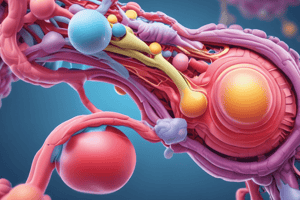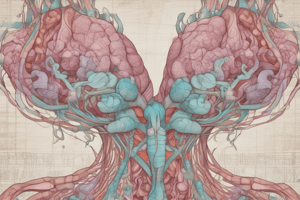Podcast
Questions and Answers
What is the main result of hypothyroidism in the body?
What is the main result of hypothyroidism in the body?
- Increased metabolic rate
- Slowing down of all body functions (correct)
- Improved cognitive function
- Enhanced physical growth
Which condition is associated with growth and developmental retardation in infants and children due to hypothyroidism?
Which condition is associated with growth and developmental retardation in infants and children due to hypothyroidism?
- Hyperthyroidism
- Goiter
- Dwarfism
- Cretinism (correct)
What laboratory finding is typical in the diagnosis of hypothyroidism?
What laboratory finding is typical in the diagnosis of hypothyroidism?
- Low levels of free T4 and elevated TSH (correct)
- Normal free T4 and low TSH
- High free T4 with normal TSH
- High levels of free T4 and TSH
Which of the following is not a cause of hypothyroidism?
Which of the following is not a cause of hypothyroidism?
What is the treatment for drug-induced hypothyroidism?
What is the treatment for drug-induced hypothyroidism?
In infants, what is the recommended daily dosage of levothyroxine for hypothyroidism treatment?
In infants, what is the recommended daily dosage of levothyroxine for hypothyroidism treatment?
Which of the following statements about Hashimoto's thyroiditis is true?
Which of the following statements about Hashimoto's thyroiditis is true?
What differentiates dyshormoogenesis from other causes of hypothyroidism?
What differentiates dyshormoogenesis from other causes of hypothyroidism?
Which skin condition is associated with hyperthyroidism?
Which skin condition is associated with hyperthyroidism?
What metabolic change is observed in hypothyroidism?
What metabolic change is observed in hypothyroidism?
What reproductive effect is commonly seen in hypothyroidism?
What reproductive effect is commonly seen in hypothyroidism?
Which of the following is a haematopoietic effect of hyperthyroidism?
Which of the following is a haematopoietic effect of hyperthyroidism?
What renal effect is observed in hyperthyroidism?
What renal effect is observed in hyperthyroidism?
What is a common musculoskeletal symptom of hypothyroidism?
What is a common musculoskeletal symptom of hypothyroidism?
Which neurological symptom is linked with hyperthyroidism?
Which neurological symptom is linked with hyperthyroidism?
What gastrointestinal change is associated with hypothyroidism?
What gastrointestinal change is associated with hypothyroidism?
What metabolic change occurs in hyperthyroidism concerning insulin?
What metabolic change occurs in hyperthyroidism concerning insulin?
Which of the following describes the skin condition associated with hypothyroidism?
Which of the following describes the skin condition associated with hypothyroidism?
What is the primary mechanism of action for Thioamides?
What is the primary mechanism of action for Thioamides?
Which Thioamide is about ten times more effective than propylthiouracil?
Which Thioamide is about ten times more effective than propylthiouracil?
What percentage of Methimazole is excreted via the kidneys in the first 48 hours?
What percentage of Methimazole is excreted via the kidneys in the first 48 hours?
Which drug has a bioavailability of about 50-80% and a short half-life of approximately 1.5 hours?
Which drug has a bioavailability of about 50-80% and a short half-life of approximately 1.5 hours?
What is the average daily dose for Methimazole?
What is the average daily dose for Methimazole?
Why is Propylthiouracil preferred during pregnancy?
Why is Propylthiouracil preferred during pregnancy?
What happens to Methimazole and Carbamizole when administered?
What happens to Methimazole and Carbamizole when administered?
What occurs to the half-life of Methimazole despite its short duration?
What occurs to the half-life of Methimazole despite its short duration?
What is the primary mechanism of action for T4 and T3 in the cells?
What is the primary mechanism of action for T4 and T3 in the cells?
Which tissues have a large number of T3 receptors?
Which tissues have a large number of T3 receptors?
How does T4 compare in affinity to the T3 receptor?
How does T4 compare in affinity to the T3 receptor?
Which form of thyroxine is associated with activation in the body?
Which form of thyroxine is associated with activation in the body?
What role do specific T3 receptor proteins play in the body?
What role do specific T3 receptor proteins play in the body?
Where is reverse T3 primarily found in the body?
Where is reverse T3 primarily found in the body?
What is a consequence of using the radioactive iodine treatment in hyperthyroidism for patients over 40 years old?
What is a consequence of using the radioactive iodine treatment in hyperthyroidism for patients over 40 years old?
What is the primary role of beta blockers in the treatment of thyrotoxicosis?
What is the primary role of beta blockers in the treatment of thyrotoxicosis?
What is the primary treatment for a thyroid storm?
What is the primary treatment for a thyroid storm?
Which agent is commonly used for thyroid hormone synthesis blockade?
Which agent is commonly used for thyroid hormone synthesis blockade?
During pregnancy, which treatment approach is recommended for women with thyrotoxicosis?
During pregnancy, which treatment approach is recommended for women with thyrotoxicosis?
What is the recommended dosage for Propanolol during a thyroid storm?
What is the recommended dosage for Propanolol during a thyroid storm?
What is a critical component of supportive therapy in managing thyrotoxicosis?
What is a critical component of supportive therapy in managing thyrotoxicosis?
Which of the following is NOT a symptom of thyrotoxicosis?
Which of the following is NOT a symptom of thyrotoxicosis?
Flashcards are hidden until you start studying
Study Notes
Mechanism of Action of Thyroid Hormones
- T4 and T3 dissociate from thyroglobulin proteins and enter cells by diffusion or active transport.
- T4 binds to specific T3 receptor proteins in the nucleus, with alpha and beta forms present.
- Major sites of T3 receptors include the liver, kidney, heart, lungs, skeletal muscles, pituitary, and intestines, with lesser amounts in the brain, spleen, and testes.
- Binding activates receptors, increasing RNA formation and protein synthesis, leading to physiological responses.
- T4 has about 10 times lower affinity for T3 receptors compared to T3.
Chemistry of Thyroid Hormones
- T4 (Thyroxine) is converted to T3 (Triiodothyronine) through deiodination for activation.
- Reverse T3, an inactive form, is also produced.
- All forms of thyroid hormones are levo-isomers.
Pharmacological Effects of Thyroid Hormones
-
Thyrotoxicosis:
- Warm, moist skin; heat intolerance; excessive sweating; thin hair; periorbital dermopathy.
- Increased basal metabolic rate; hyperglycemia; elevated triglycerides and cholesterol; weight loss.
- Menstrual irregularities and increased gonad steroid metabolism.
- Increased erythropoiesis and possible anemia.
- Mild polyuria; increased renal blood flow; increased GFR.
- Nervousness; hyperkinesia; emotional liability; insomnia.
- Increased appetite; frequent bowel movements.
-
Hypothyroidism:
- Pale, cool, puffy skin; dry, brittle hair; brittle nails.
- Decreased basal metabolic rate; delayed insulin degradation; reduced triglycerides and cholesterol.
- Infertility, decreased libido, and menstrual irregularities.
- Decreased erythropoiesis; possible anemia.
- Decreased renal blood flow; reduced GFR; impaired water excretion.
- Stiffness, muscle fatigue; decreased deep tendon reflexes.
- Lethargy; general slowing of mental processes.
- Decreased appetite; less frequent bowel movements.
Hypothyroidism Overview
- Syndrome resulting from a deficiency of thyroid hormones, reversible but leads to slowing of body functions.
- In infants, can cause growth and developmental retardation, possibly resulting in dwarfism and irreversible mental retardation.
- Diagnosis involves low free T4 and elevated serum TSH levels.
Causes of Hypothyroidism
- Drug-Induced: Medications like lithium, fluoride, thioamide blockers, etc., lead to mild to moderate hypothyroidism.
- Dyshormogenesis: Impaired synthesis of T4 due to enzyme deficiencies; may present with goiter.
- Destruction/Removal: Radiation, thyroidectomy leads to severe hypothyroidism without goiter.
- Congenital: Cretinism due to iodine deficiency; severe hypothyroidism results.
- TSH Absence: Pituitary/hypothalamic disorders lead to mild hypothyroidism.
- Hashimoto's Thyroiditis: Autoimmune destruction of the thyroid; progression from goiter to mild/moderate hypothyroidism is common.
Management of Hypothyroidism
- Withdrawal of drugs causing hypothyroidism, with short-term levothyroxine replacement therapy.
- Levothyroxine dosage for infants is typically 10-15 µg/kg/day, while adults require about 1.7 µg/kg/day.
- Other management techniques involve modifications of tissue response to hormones and surgical interventions.
Thioamides
- Include Methimazole, Carbamizole, and Propylthiouracil; Carbamizole is ten times more effective than Propylthiouracil.
- Mechanism: They prevent hormone synthesis by inhibiting thyroid peroxidase and block iodine organification.
- Side effects may include radiation-induced genetic damage; caution is advised for patients over 40.
Beta Blockers
- Useful for symptom control in thyrotoxicosis as they counteract sympathetic stimulation.
- Propranolol is the most commonly used beta blocker for managing symptoms.
Thyroid Storm
- Acute exacerbation of thyrotoxicosis symptoms; life-threatening condition.
- Treatment includes Propranolol, Diltiazem, potassium iodide, iodinated contrast agents, and corticosteroids.
Thyrotoxicosis in Pregnancy
- Recommended treatment includes subtotal thyroidectomy and Iodine I^131.
- Propylthiouracil is used during pregnancy, and thyroid supplements may be necessary post-surgery.
Studying That Suits You
Use AI to generate personalized quizzes and flashcards to suit your learning preferences.




